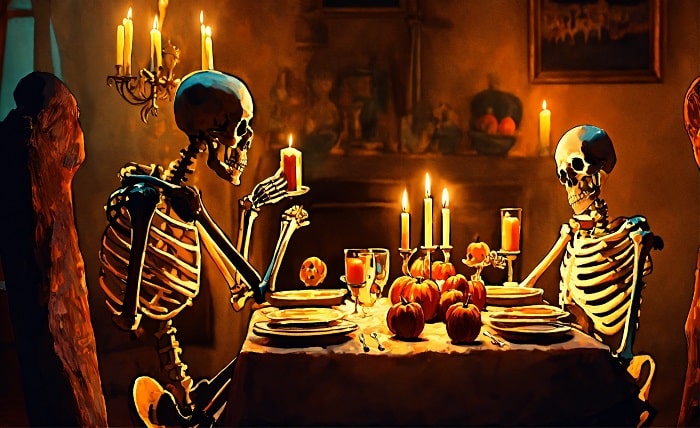Unveiling the Haunting Truth: The 1982 Movie Poltergeist Used Real Skeletons as – Tymoff

Introduction
The 1982 movie Poltergeist is a cornerstone of horror cinema, renowned for its spine-chilling story and groundbreaking special effects. However, one of the most unsettling aspects of the film is the revelation that real skeletons were used as props during production. This decision has sparked controversy and fascination, adding an eerie layer to the movie’s already haunting legacy. In this blog post, we will delve deep into the chilling truth behind the 1982 movie Poltergeist used real skeletons as – Tymoff, exploring the reasons, impact, and lingering questions surrounding this macabre choice.
The Decision to Use Real Skeletons
The 1982 movie Poltergeist used real skeletons as props due to practical and economic reasons. At the time, it was cheaper and more accessible to source real human skeletons from medical supply companies than to create realistic-looking fake skeletons. This decision, however, has become one of the most infamous aspects of the film, raising ethical and moral questions about the use of human remains in entertainment.
Behind-the-Scenes Insights
During the production of the 1982 movie Poltergeist, the decision to use real skeletons was made to enhance the authenticity of the scenes, particularly in the infamous swimming pool scene. Special effects artist Craig Reardon confirmed that real human skeletons were indeed used, adding a layer of authenticity that fake skeletons couldn’t match. This behind-the-scenes choice contributed significantly to the film’s eerie atmosphere.
The Infamous Swimming Pool Scene
One of the most iconic moments in the 1982 movie Poltergeist used real skeletons as props is the swimming pool scene, where actress JoBeth Williams’ character encounters several skeletons. The use of real skeletons in this scene has been widely discussed and debated, with many fans finding the revelation both fascinating and disturbing. This scene has become a focal point in discussions about the film’s production choices.
Ethical and Moral Implications
The use of real skeletons in the 1982 movie Poltergeist raises significant ethical and moral questions. While the practice was not uncommon in the film industry at the time, it has since been criticized for showing a lack of respect for human remains. The revelation that the 1982 movie Poltergeist used real skeletons as props has led to discussions about the responsibilities of filmmakers in treating such materials with dignity.
The Impact on Cast and Crew
The decision to use real skeletons in the 1982 movie Poltergeist had a profound impact on the cast and crew. Actress JoBeth Williams, who was directly involved in the swimming pool scene, later expressed her discomfort upon learning that the skeletons were real. This knowledge added a layer of unease and horror for those involved in the film, contributing to the legend of the “Poltergeist curse.”
The Poltergeist Curse
The 1982 movie Poltergeist used real skeletons as props, contributing to the infamous “Poltergeist curse” that has haunted the film and its sequels. Several tragic events, including the untimely deaths of cast members, have been linked to the film, leading some to believe that the use of real human remains brought bad luck or even a curse upon those involved. This notion has become a part of the film’s enduring legacy.
Public Reaction and Controversy
When the truth about the 1982 movie Poltergeist using real skeletons as props became widely known, it sparked a significant public reaction and controversy. Fans and critics alike were shocked and appalled by the revelation, leading to debates about the ethics of using human remains in film. The controversy has continued to be a topic of discussion among horror enthusiasts and film historians.
Legal and Regulatory Changes
The revelation that the 1982 movie Poltergeist used real skeletons as props has had lasting effects on the film industry. In response to the controversy, there have been increased regulations and guidelines regarding the use of human remains in film production. These changes aim to ensure that such practices are conducted with respect and dignity, preventing similar controversies in the future.
The Legacy of Poltergeist
Despite the controversy, the 1982 movie Poltergeist remains a classic in the horror genre, celebrated for its innovative effects and gripping story. The use of real skeletons as props has become a part of its legacy, adding to the film’s mystique and horror. This legacy continues to fascinate and horrify new generations of fans, ensuring that Poltergeist remains a topic of discussion and analysis.
The Enduring Fascination
The fact that the 1982 movie Poltergeist used real skeletons as props continues to captivate audiences and researchers. This macabre detail adds a layer of authenticity and horror to the film that few other movies can match. As horror fans and film scholars continue to explore the depths of Poltergeist’s production, the use of real skeletons remains one of the most intriguing and disturbing aspects of this iconic film.
Conclusion
The 1982 movie Poltergeist used real skeletons as props, a decision that has left an indelible mark on the film’s history and legacy. This choice, driven by practicality, has sparked controversy, ethical debates, and a lasting fascination with the film’s production. While it adds an eerie authenticity to the movie, it also serves as a reminder of the importance of ethical considerations in filmmaking. The haunting truth behind Poltergeist continues to captivate and disturb, ensuring its place as a cornerstone of horror cinema.
FAQs
1. Why did the 1982 movie Poltergeist use real skeletons as props?
The 1982 movie Poltergeist used real skeletons as props because it was more cost-effective and practical than creating realistic fake skeletons. This decision aimed to enhance the authenticity of the film’s horror scenes.
2. How did the cast react to the use of real skeletons in Poltergeist?
Many cast members, including actress JoBeth Williams, expressed discomfort and unease upon learning that real skeletons were used. This revelation added a layer of horror and unease during the production.
3. What is the Poltergeist curse?
The Poltergeist curse refers to a series of tragic events and untimely deaths of cast members associated with the film and its sequels. Some believe that the use of real skeletons contributed to this curse, adding to the film’s eerie legacy.
4. Were real skeletons commonly used in films during the 1980s?
Yes, during the 1980s, it was not uncommon for real skeletons to be used in films due to their availability and cost-effectiveness. However, this practice has since become less common due to ethical concerns and increased regulations.
5. How has the revelation about real skeletons in Poltergeist impacted the film industry?
The controversy surrounding the use of real skeletons in Poltergeist has led to increased scrutiny and regulations in the film industry regarding the use of human remains. This aims to ensure ethical practices and respect for human dignity in future productions.



